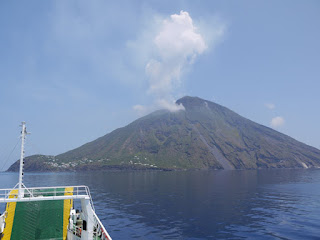My year began and ended with trips to Venice, my home from home, always so much better outside the peak tourist season.
Venice is wonderful in winter, with few(er) tourists, space to breathe & much more atmosphere. pic.twitter.com/Dgh79oqAn7
— Emily@italyheaven (@italyheaven) November 30, 2015
Walking the murazzi pic.twitter.com/FnU7vjK5i3
— Emily@italyheaven (@italyheaven) March 14, 2015
In April I visited the low-key island of Ustica. Nights were cold but the days were warm and sunny, and I walked the entire circumference of the island on attractive flower-strewn footpaths.
This was my view at lunchtime pic.twitter.com/vEspDhswCw
— Emily@italyheaven (@italyheaven) April 12, 2015
In June I visited the lovely Aeolian islands. First stop was posh little Panarea, where I enjoyed the views and - on a very hot day - climbed to the island's summit.
Current location. Office with a view. pic.twitter.com/56tCZWOL5q
— Emily@italyheaven (@italyheaven) June 9, 2015
I thought my heart might give out this morning clambering uphill in the heat, but I made it. This was the view. pic.twitter.com/TkvduXuaJO
— Emily@italyheaven (@italyheaven) June 10, 2015
I caught the delivery boat to the volcano island Stromboli, where I ate a pizza at dusk while watching the volcano's eruptions.
Slow boat to Stromboli pic.twitter.com/gFdTVxyUIs
— Emily@italyheaven (@italyheaven) June 11, 2015
The islands are great for delicious and affordable eating. I sampled an ice granita every day (essential for cooling down on hot days).
The islands have been good for snacks. Here's a mouthwatering pistachio arancino, in Santa Maria Salina. pic.twitter.com/jJ2GTspKCr
— Emily@italyheaven (@italyheaven) June 12, 2015
My second granita of the day was this amazing doubledecker with mulberry and fig, at Da Alfredo, Lingua. pic.twitter.com/xpZZfYAyth
— Emily@italyheaven (@italyheaven) June 12, 2015
This year I've visited quite a few volcanoes. I walked around the crater of Vulcano on another blazingly hot day.
The things I do for research... pic.twitter.com/3v2XEwtJFz
— Emily@italyheaven (@italyheaven) June 16, 2015
Amazing coloured sea on this side of Lipari. (Lots of white pumice underwater). pic.twitter.com/XaMSoQ4cdk
— Emily@italyheaven (@italyheaven) June 21, 2015
I returned to the islands in September for more island ascents - and a leisurely boat trip.
We've come ashore at Lingua, where I'm happy to find Alfredo's famous pane cunzato comes in half portions. pic.twitter.com/kVHTcMcx7t
— Emily@italyheaven (@italyheaven) September 5, 2015
In October I visited Taormina with my parents and visited another volcano.
My dad & I enjoyed a fascinating Etna tour from Taormina with Paolo @EtnaPeople. Learned lots - I'd recommend it. pic.twitter.com/kSd9jq2fdD
— Emily@italyheaven (@italyheaven) October 24, 2015
We visited the atmospheric village of Savoca and stayed in the excellent Borgo San Rocco run by the wonderful Vittorio, to whom all guests are personal friends.
Savoca, a Sicilian village in the hills above the sea. pic.twitter.com/IwjWKKB6iE
— Emily@italyheaven (@italyheaven) October 19, 2015
There were lots of memorable moments in Rome in November, including a return to the wonderful palace of Nero and my favourite Roman meal, pasta with squash flowers at a trattoria called Da Carlone in Trastevere.
Hard hat on for a return to Nero's Golden House, 15 years since my last visit. pic.twitter.com/Cm9IRso5Hg
— Emily@italyheaven (@italyheaven) November 22, 2015
I made a video of the daily life and starling murmurations of Rome.
On a pre-Christmas trip to Venice I enjoyed the peace of the city and made a few videos to show some of the different facets of the city.
Christmas coming to Venice. pic.twitter.com/6kVxYVOkMA
— Emily@italyheaven (@italyheaven) December 4, 2015
I haven't made my travel plans for 2016, but if you follow me on Twitter or visit the Italy Heaven website and this blog, you can catch up with my latest destinations, discoveries, meals, ice drinks and off-the-beaten-track experiences, as well as all the latest website updates and Italy recommendations.
























.jpg)
